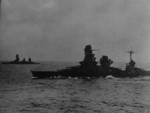Encouraçado da Classe Ise
| País | Japão |
Contributor: C. Peter Chen
This article refers to the entire Ise-class; it is not about an individual vessel.
ww2dbaseThe Ise-class battleships were built in the 1910s, and in the 1930s received modernizations that included improved machinery, armor, and fire control. Although the reconstructions in the 1930s were extensive, the most significant conversion that the Ise-class ships saw during their careers was the conversion in 1943 that made them hybrid battleship-carriers. Their two aft turrets (No. 5 and No. 6) were removed to make space for 70-meter flight decks and 40-meter hangars. The flight decks had a 200-milimeter layer of concrete in order to maintain the weight distribution that would otherwise be in imbalance due to the removal of the turrets. In their resulting hybrid forms, they were able to carry 22 aircraft each (9 on flight deck, 11 in hangar, and 2 on catapults). Theoretically the conversion of battleships Ise and Hyuga bolstered the strength of the Japanese Navy in the air, but Japan's lack of sufficiently trained pilots meant that these hybrid ships were never fully used in their new roles.
ww2dbaseSource: Imperial Japanese Navy Battleships 1941-45.
Last Major Revision: Feb 2009
Encouraçado da Classe Ise Mapa Interativo
Photographs
 |
Encouraçado da Classe Ise Operational Timeline
| 1 dez 1917 | Ise was commissioned into service. |
| 30 abr 1918 | Hyuga was commissioned into service. |
| 11 mar 1942 | Shokaku and Zuikaku accompanied Vice Admiral Takasu Shiro's First Fleet (Ise and Hyuga) on a sortie to sweep for enemy believed to approaching Japan. |
| 25 out 1944 | Off northeastern Luzon, Philippines, aircraft from US Navy Task Force 38 attacked the Japanese carrier force consisted of fleet carrier Zuikaku and light carriers Zuiho, Chitose, and Chiyoda in the Battle off Cape Engaño. The Japanese force was escorted by two battleship-carrier hybrids (Hyuga and Ise; aircraft-less on this date), three light cruisers (Oyodo, Tama, and Isuzu), and nine destroyers at about 0830 hours, 26 minutes after those planes were detected by Zuikaku's radar. The overwhelmingly larger American force, under Admiral William Halsey, centered around fleet carriers USS Lexington, USS Intrepid, USS Essex, USS Franklin, USS Enterprise, further bolstered by a great many light carriers, battleships, cruisers, and destroyers. Zuikaku was damaged by skilled damage control teams extinguished the fires and corrected the listing by 0850 hours. Chitose was fatally damaged by the first attack wave, sinking at 0937 hours. At 0953 hours, a second attack wave struck, fatally damaging Chiyoda, leaving her dead in the water to be sunk by American destroyers later at 1655 hours. The second wave also damaged Zuiho's flight deck, the last functional flight deck of Vice Admiral Jisaburo Ozawa's force; Japanese combat air patrol planes in the air would need to ditch when they ran out of fuel. At 1032 hours, Ozawa transferred his flag from the damaged Zuikaku to Oyodo. At 1308, the Japanese sighted an incoming third wave of American aircraft. Six torpedoes struck Zuikaku, causing massive flooding and several fires in the hangar; the commanding officer addressed the surviving crew, ordered the lowering of the ensign, and gave the abandon ship order at 1358 hours; Zuikaku sank by the stern at 1414 hours. Zuiho suffered two torpedo, two bomb hits, and a great many near-misses during the third attack wave, and she was dead in the water at 1445 hours. At 1455 hours, a fourth wave struck, sealing the doom of Zuiho with ten near-misses, leading to Zuiho's commanding officer giving the abandon ship order; she sank at 1526 hours. |
| 30 dez 1944 | Japanese convoy HI-84 sailed past battleship-carrier Ise, battleship-carrier Hyuga, cruiser Oyodo, cruiser Ashigara, destroyer Asashimo, and destroyer Kasumi in the South China Sea in the morning. At 1157 hours, HI-84 arrived at Binhoang Bay, French Indochina. |
| 24 jul 1945 | British TF 37 launched 416 sorties, 261 of which were sent against the Japanese home islands and 155 were for defensive patrols; escort carrier Kaiyo was damaged by British carrier planes. On the same day, American TF 38 launched 600 aircraft against Kure, Nagoya, Osaka, and Miho, sinking battleship-carrier Hyuga, heavy cruiser Tone, and target ship Settsu, and damaging carrier Ryuho, carrier Amagi, battleship-carrier Ise, battleship Haruna, heavy cruiser Aoba, light cruiser Oyodo, transport Kiyokawa Maru; the Aichi aircraft factories at Nagoya were seriously damaged. |
| 28 jul 1945 | 137 American P-47 aircraft based in Ie Shima, Okinawa, Japan attacked targest in Kyushu, Japan. On the same day, 471 B-29 bombers attacked smaller Japanese cities in the home islands with incendiary bombs. Finally, from the sea, US Navy carrier aircraft struck various Inland Sea ports between Nagoya and northern Kyushu, sinking battleship Haruna, battleship-carrier Ise, heavy cruiser Aoba (in shallow water), and light cruiser Oyodo, and damaging carrier Katsuragi, carrier Hosho, and already beached battleship Settsu. |
Você gostou deste artigo ou achou este artigo útil? Se sim, considere nos apoiar no Patreon. Qualquer valor já vai ajudar! Obrigado. Por favor, ajude-nos a divulgar o site: Fique atualizado com WW2DB: |

» Hyuga
» Ise
- » 1,182 biografias
- » 337 eventos
- » 45,119 entradas na linha do tempo
- » 1,248 navios
- » 350 modelos de aeronaves
- » 207 modelos de veículos
- » 376 modelos de armas
- » 123 documentos históricos
- » 261 instalações
- » 470 resenhas de livros
- » 28,409 fotos
- » 365 mapas
Lt. Gen. Lewis B. "Chesty" Puller, at Guadalcanal
Por favor, considere nos apoiar no Patreon. Mesmo R$1 por mês já faz uma grande diferença. Obrigado!
Ou, por favor, nos apoie adquirindo alguns produtos do WW2DB na TeeSpring. Obrigado!